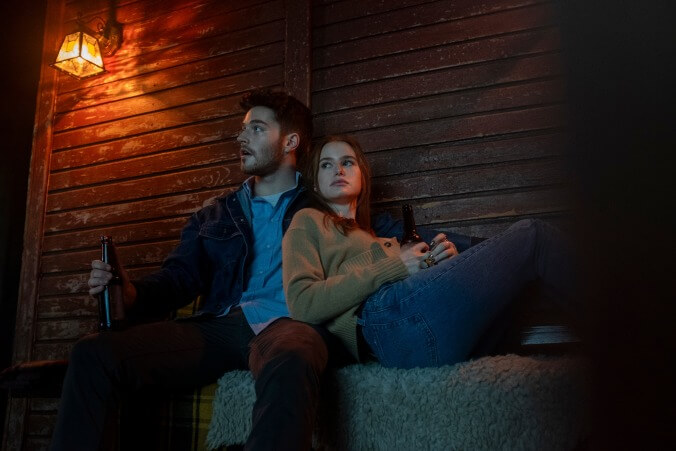Froy Gutierrez and Madeline Petsch
Photo: John Armour (Lionsgate)
After 16 years of axe-wielding, needle-dropping, and door-knocking scares, The Strangers have become all too familiar. When Bryan Bertino’s 2008 original asked, “Is Tamara home?” the home invasion felt like a novel avenue for slashers. With added authenticity and a sense of criminal mundanity, The Strangers became a sleeper hit and a cult landmark that inspired a modestly successful sequel a decade later. The stylishly playful Prey By Night lined horror clichés with irony. The Strangers: Chapter 1 sees those same tropes as a roadmap. For the first part of a planned reboot trilogy, The Strangers: Chapter 1 is best experienced by a Strangers neophyte. Working from a script by Alan R. Cohen and Alan Freedland, director Renny Harlin takes the premise of Bertino’s film and gives it a commercial makeover, turning the grainy originality of its forbearer into just another horror movie.
Like its predecessors, Chapter 1 opens with a disclaimer. The movie we are about is see is “based on true events,” and “1.4 million violent crimes are committed in America every year.” The information lends some Texas Chain Saw verisimilitude the movie works overtime to subvert. The commitment to realism dissipates when we meet our leads, Maya (Riverdale’s Madelaine Petsch) and Ryan (Froy Gutierrez). Driving cross-country for Maya’s new job in Portland, the couple breaks down in Venus, Oregon—population: three strangers. Teeming with “you’re not from ‘round these parts” vibes, the creepy townspeople (who must factor into the sequels, considering how much screentime they get) send Maya and Ryan to a secluded “internet hotel” in the woods.
The setup is a marked step down from the original, which saw Liv Tyler and Scott Speedman attempt to distract the audience with a cryptic relationship drama. Not knowing their conflict forced viewers to play catch-up with a situation that ultimately wouldn’t matter. It was diverting the viewer’s attention that was paramount. Chapter 1 simply gives the victims a one-way ticket to the Evil Dead cabin to get it over with. It’s as if we’re just killing time until Dollface (Olivia Kreutzova) knocks on the door.
Harlin is no stranger to horror, having mounted sequels and prequels to Nightmare On Elm Street and The Exorcist—though hardly the most memorable or beloved entries. He spent much of his Hollywood career in action movies, directing blockbusters like Die Hard 2, Cliffhanger, and cult favorite The Long Kiss Goodnight. He brings a tight professionalism to The Strangers, giving the movie the slick sheen of a studio slasher with plenty of scares.
When the cabin door first begins a-knocking, Harlin and Petsch, who makes a sympathetic lead despite the illogical clichés the script forces her into, squeeze the viewer with dread. Harlin manages some effective variety of scares, creating sequences of tension, gore, and some clever jumps. One crawlspace escape features a well-placed nail that should clear up any concerns about The Strangers losing its sadistic edge. But even in those moments, Harlin can’t help but telegraph what’s coming next. Throughout the invasion, any time there’s negative space in Maya or Ryan’s frame, we can tell a stranger will sofill it.
At each stage of Maya and Ryan’s ordeal, Harlin can’t help but smooth over the original’s rough edges. The result is more of a remake than a legacy sequel. As the Scarecrow (Matus Lajcak) stalks Maya around the cabin, his moves feel predetermined by Strangers memes. A vinyl record must be played, and an innocent person must be shot by accident. By the time the couple makes it to a pickup in the driveway, the echoes of the first two movies ring too loudly for the scene to hold any great power.
The added scope of the series is where the balance starts to wobble. Harlin begins to imbue his killers with the mythological stature of Michael Myers or Jason Voorhees. With cinematographer José David Montero, whose sickly blue-green color palate reminds viewers just how close Venus is to Twilight’s Forks, Washington, Harlin frames the Scarecrow from the forest floor, making him appear as tall as a Redwood, fee-fi-fo-fumming Ryan around the woods. From this vantage, The Strangers no longer looks like something that can happen to anyone, but rather something that can only happen to someone in a Strangers movie.
Chapter 1's derivative script calls the whole three-movie endeavor into question. With two more installments and a four-and-a-half-hour mega-movie on the way, Harlin plans to expand the universe and settle the mysteries that made the series so destabilizing. Those creepy bike-riding kids, off-putting diner patrons, and menacing mechanics must mean something to the broader story, right? By looking at the minimalist Strangers through a maximalist lens, Harlin hopes to reveal a grander vision for the franchise, where we learn who Tamara is and why, exactly, the strangers are doing this. “Because you’re here” isn’t a satisfying enough answer, even if that’s the answer. Like so many horror movies subject to over-expansion, the more the films unmask their villains, the less threatening they become.






![HBO teases new Euphoria, Larry David, and much more in 2026 sizzle reel [Updated]](https://img.pastemagazine.com/wp-content/avuploads/2025/12/12100344/MixCollage-12-Dec-2025-09-56-AM-9137.jpg)


































